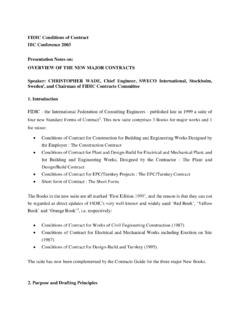Transcription of Medical Conditions List and Transportation Indicators
1 Medical Conditions List and Transportation Indicators CMS Transmittal 3240, Change Request (CR) 9142 issued April 24, 2015 - The ICD-9-CM Medical Conditions List and Transportation Indicators list that was previously in Chapter 15, section 40 of the Claims Processing Manual has been moved to the CMS Web site. The Medical Conditions list is intended as primarily an educational guideline. This list was most recently updated by CMS Transmittal 1185, Change Request 5542 issued February 23, 2007. It will help ambulance providers and suppliers to communicate the patient's condition to Medicare contractors, as reported by the dispatch center and as observed by the ambulance crew.
2 Use of the Medical Conditions list does not guarantee payment of the claim or payment for a certain level of service. Ambulance providers and suppliers must retain adequate documentation of dispatch instructions, patient's condition, other on-scene information, and details of the transport ( , medications administered, changes in the patient's condition, and miles traveled), all of which may be subject to Medical review by the Medicare contractor or other oversight authority. Medicare contractors will rely on Medical record documentation to justify coverage, not simply the HCPCS code or the condition code by themselves.
3 All current Medicare ambulance policies remain in place. The Medical Conditions List is set up with an initial column of primary ICD-9-CM codes, followed by an alternative column of ICD-9-CM codes. The primary ICD-9-CM code column contains general ICD-9-CM codes that fit the transport Conditions as described in the subsequent columns. Ambulance crew or billing staff with limited knowledge of ICD-9-CM coding would be expected to choose the one or one of the two ICD-9-CM codes listed in this column to describe the appropriate ambulance transport and then place the ICD-9-CM code in the space on the claim form designated for an ICD-9-CM code.
4 The option to include other information in the narrative field always exists and can be used whenever an ambulance provider or supplier believes that the information may be useful for claims processing purposes. If an ambulance crew or billing staff member has more comprehensive clinical knowledge, then that person may select an ICD-9-CM code from the alternative ICD-9-CM code column. These ICD-9-CM codes are more specific and detailed. An ICD-9-CM code does not need to be selected from both the primary column and the alternative column. However, in several instances in the alternative ICD-9-CM code column, there is a selection of codes and the word PLUS.
5 In these instances, the ambulance provider or supplier would select an ICD-9-CM code from the first part of the alternative listing (before the word PLUS ) and at least one other ICD-9-CM code from the second part of the alternative listing (after the word PLUS ). The ambulance claim form does provide space for the use of multiple ICD-9-CM codes. Please see the example below: The ambulance arrives on the scene. A beneficiary is experiencing the specific abnormal vital sign of elevated blood pressure; however, the beneficiary does not normally suffer from hypertension (ICD-9-CM code (from the alternative column on the Medical Conditions List)).
6 In addition, the beneficiary is extremely dizzy (ICD-9-CM code (fits the PLUS any other code requirement when using the alternative list for this condition (abnormal vital signs)). The ambulance crew can list these two ICD-9-CM codes on the claim form, or the general ICD-9-CM code for this condition ( Other Abnormal Clinical Findings) would work just as well. None of these ICD-9-CM codes will determine whether or not this claim will be paid; they will only assist the contractor in making a Medical review determination provided all other Medicare ambulance coverage policies have been followed.)
7 While the Medical Conditions /ICD-9- CM code list is intended to be comprehensive, there may be unusual circumstances that warrant the need for ambulance services using ICD-9- CM codes not on this list. During the Medical review process contractors may accept other relevant information from the providers or suppliers that will build the appropriate case that justifies the need for ambulance transport for a patient condition not found on the list. Because it is critical to accurately communicate the condition of the patient during the ambulance transport, most claims will contain only the ICD-9- CM code that most closely informs the Medicare contractor why the patient required the ambulance transport.
8 This code is intended to correspond to the description of the patient s symptoms and condition once the ambulance personnel are at the patient s side. For example, if an Advanced Life Support (ALS) ambulance responds to a condition on the Medical Conditions list that warrants an ALS-level response and the patient s condition on-scene also corresponds to an ALS-level condition, the submitted claim need only include the code that most accurately reflects the on-scene condition of the patient as the reason for transport. (All claims are required to have HCPCS codes on them, and may have modifiers as well.)
9 Similarly, if a Basic Life Support (BLS) ambulance responds to a condition on the Medical Conditions list that warrants a BLS-level response and the patient s condition on-scene also corresponds to a BLS-level condition, the submitted claim need only include the code that most accurately reflects the on-scene condition of the patient as the reason for transport. When a request for service is received by ambulance dispatch personnel for a condition that necessitates the skilled assessment of an advanced life support paramedic based upon the Medical Conditions list, an ALS-level ambulance would be appropriately sent to the scene.
10 If upon arrival of the ambulance the actual condition encountered by the crew corresponds to a BLS-level situation, this claim would require two separate condition codes from the Medical condition list to be processed correctly. The first code would correspond to the reason for transport or the on-scene condition of the patient. Because in this example, this code corresponds to a BLS condition, a second code that corresponds to the dispatch information would be necessary for inclusion on the claim in order to support payment at the ALS level. In these cases, when MR is performed, the Medicare contractor will analyze all claim information (including both codes) and other supplemental Medical documentation to support the level of service billed on the claim.












